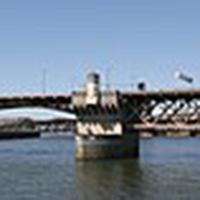Multnomah County plans to choose a company to design the bridge in July. The Burnside Bridge, built in 1926, is located on one of the longest and busiest streets in the Portland area. The five-lane Burnside is a direct connection between downtown Portland, Beaverton to the west and Gresham to the east. About 45,000 vehicles a day use it, along with about 2,000 pedestrians and 4,000 bicyclists each day. In 2019, more than 7,000 people travelled across the bridge each weekday by TriMet bus.
Portland urgently needs to get rid of the 1926 Burnside Bridge, for fear that it will fall into the river during a big earthquake. Multnomah County wants it replaced with a similar size bridge, with a lift span to let ships through. It must be able to survive an earthquake so emergency traffic can use it when most of the other Willamette bridges have collapsed.
The county already has agreed on a long-span bridge. It would have some sort of overhead supports, requiring fewer columns sunk into the potentially unstable earth. Now county officials are deciding what impact the supports will have on land around Saturday Market and the inner east side, including the famous Burnside Skatepark.
The task force planning the future of the Burnside Bridge met Monday to vote on recommendations to cut costs by $185 million to $240 million. The majority voted for a drawbridge similar to the existing one, instead of a vertical lift drawbridge, which could save about $35 million. They also voted on a different girder structure, which would cut costs by $40 million.
But the majority was against a narrower bridge. “A narrower bridge is just not the direction we need to be going for the next hundred years. Whatever mode of transportation people are using we’re going to need that width, especially in the case of a massive earthquake,” said Dennis Corwin, who is on the committee and is also the general manager of the Portland Spirit.
















